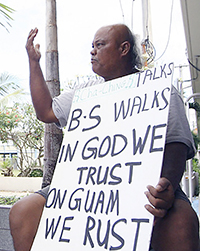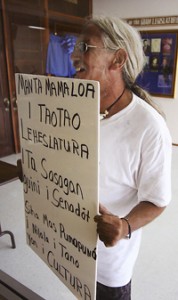Guam offers big payoff for Hawaii investors
Friday, March 20, 2009
Pacific Business News (Honolulu) – by Cathy Cruz-George
HAGATñA, Guam – In January 2007, Maria Miller left Hawaii and moved to Guam to open Horizon Properties Inc., a real estate firm serving the growing number of Hawaii investors buying homes and condominiums in Guam. She now manages more than 250 units.
Her business partner, Eric Watanabe, a 25 percent shareholder in Horizon Properties and president of Hawaii-based Eric M. Watanabe Realty, branched out and opened a Taco Del Mar franchise on Guam.
Guy Akasaki, chairman of Honolulu-based Allied Pacific Builders Inc., bought a Guam general contracting firm that now generates $4 million annually in sales. He also bought $12 million in property that he estimates is now worth $1 million more.
They are among the many Hawaii residents who invested on Guam in the past four years in anticipation of the U.S. military’s plans to move 8,000 Marines, along with 9,000 dependents, from Okinawa to the U.S. territory by 2014.
Starting in the 1970s, dozens of big Hawaii companies opened branches on Guam in response to the growth of tourism and construction, including Bank of Hawaii, First Hawaiian Bank, Sam Choy’s, Roy’s Restaurant, Finance Factors, Matson Navigation Co. Inc., Outrigger Hotels & Resorts and Castle Resorts & Hotels.
The recent wave of Hawaii companies, however, comprises new, smaller players hoping to diversify and grab a share of the military boom.
“Three years ago, I saw signs of the Hawaii economy starting to drop,” Akasaki said. “You anticipate that good times are not always going to be, so you start preparing for a famine.”
Already, 8,000 active-duty military personnel live on Guam, located 3,800 miles west of Hawaii and a three-hour plane ride from Asia. Approximately 1.2 million tourists visit Guam annually, the majority hailing from Japan, Korea and Taiwan.
For Guam’s 170,000 residents to accommodate the population surge by 2014, the island – slightly smaller than Molokai – will require additional homes, roads, schools and other badly needed infrastructure.
The U.S. and Japan governments earmarked $10 billion and $6 billion, respectively, for relocation and building expenses.
“This is the calm before things start taking off,” said Ronald Cannoles, executive vice president and Pacific Islands division manager for Bank of Hawaii on Guam, with $470 million in assets.
Billions in military money
Over the next decade, the U.S. government plans to spend an additional $5 billion for Army, Navy and Air Force expansion on Guam.
Once construction begins in late 2010, between $1 billion and $2 billion annually in federal funding is expected to flow into Guam’s economy, up from an annual average of $600 million in private and public construction, according to the Guam Contractors Association.
Guam’s economic situation is unique, said Nicholas Captain, an Asia-Pacific real estate analyst.
“The military buildup is going to buffer any downsize that the economy has as a result of the fallout from the credit market collapse and the recession in Hawaii and the Mainland,” said Captain, president of the Guam-based Captain Real Estate Group of Cos., and an alumnus of the University of Hawaii.
To fill jobs, the contractors’ association estimates that the industry will need up to 20,000 workers, mainly from Guam, the Commonwealth of the Northern Mariana Islands, Micronesia and the Philippines.
Finding employees will not be “rocket science” for Guam’s construction industry, which experienced a tourism-building boom in the late 1980s before the Japanese bubble burst, said Denny Watts, president of Honolulu-based Watts Constructors.
“Guam has been resilient over the years about taking care of those needs,” said Watts, who opened a Guam branch three years ago and employs about 25 salaried and 100 hourly workers.
John Sage, originally from New Zealand, manages the Guam office of Watts Constructors, which has annual sales of about $60 million. This year, the Guam team finished building a 185,000-square-foot base exchange at Anderson Air Force Base and is almost finished with an $82 million, 200-unit housing project for the Navy.
Guam’s biggest challenge will be to find workers with highly specialized skills, such as military project management and contract administration.
Although Watts plans to fill jobs with local residents, the industry might need Hawaii and Mainland workers to fill the void, Watts said.
More than 600 résumés for jobs on Guam, mostly from the U.S. Mainland, arrived in his Honolulu office in early March in response to a help-wanted ad in a national magazine.
Home prices to rise
Construction workers moving to Guam will provide an “additional boom” to the real estate market as they rent or buy homes, said James Martinez, president of the contractors’ association, which two years ago created the GCA Trades Academy, a skills-training program that guarantees jobs for local residents.
“The downside is these workers are normally transient and would move back or closer to home if the economic situation improves back in the U.S.,” he said.
That is one of Maria Miller’s major concerns, having seen Hawaii residents priced out of the market after home prices escalated.
“I really don’t want to see that happen here,” said Miller, the property manager who looks after homes on Guam for Hawaii-based owners.
Ron Ramos, CEO and principal broker of the Guam branch of Hawaii real estate firm NAI Chaney Brooks, says a military housing market could inflate home prices similar to what happened in Honolulu.
“We have to strike a balance in working with the military,” he said. “There could be a disconnect between what the locals and the military can afford.”
NAI Chaney Brooks, which opened a Guam office in 2007, has been involved in $2 billion in real estate transactions on the island.
The company plans to convert the luxury golf residence LeoPalace Resort into military housing and has joined with Matson Navigation Co. Inc. to secure and develop an industrial park on Guam.
Unlike Hawaii, Guam didn’t recover from the Asian economic downturn until the mid-2000s and its real estate values remained bargain-basement compared to Hawaii’s.
From 2005 to early 2008, Hawaii investors were among the buyers who took advantage of Guam’s territorial status, which enabled them to do a Section 1031 Exchange that allowed them to sell and buy like-kind property without paying capital gains.
“Smart people sold out of the Mainland and Hawaii when those market were peaking,” Captain said. “Guam was coming out of an incredibly depressed time and the real estate prices were extremely low, just a fraction of the prices on the Mainland.”
The median price of a single-family home on Guam increased 19 percent from 2006 to 2007, hitting $196,850.
In 2008, the median home price rose to $215,000, up another 9 percent. The median price of industrial property last year rose 44 percent to $1.3 million.
Despite the growth, real estate sales volume fell 46 percent last year as the worldwide financial crisis worsened.
Sales are expected to fall another 12 percent in the first two quarters of 2009 before rebounding in the latter half of the year.
The real estate numbers mirror Bank of Hawaii’s Guam operations, which saw loan volume grow 20 percent between 2007 and early 2008, as speculative buyers flooded the market. Loan volume has flattened since then.
Bank of Hawaii saw Guam deposits rise 3 percent in 2008 as businesspeople “took a conservative approach to capital expenditures and building up of inventories, watching what will happen in the global economic crisis,” Cannoles said.
Taking too long
First Hawaiian Bank’s Guam division, with $600 million in assets, also saw an increase in loans after the military’s initial announcement three years ago but later noted a slowdown when investors realized the buildup would take longer than anticipated.
“When they initially announced the buildup three years ago, they thought the military was coming sooner,” said Laura-Lynn Dacanay, senior vice president and regional manager for Guam and the region. “Once [Secretary of State] Hillary Clinton signed the agreement with Japan, it gave new momentum.”
Guam’s population growth means increased volume for shipping companies Charlotte, N.C-based Horizon Lines Inc. and Matson Navigation, which together handle 80 percent of containers at Guam’s commercial port in Apra Harbor.
Earlier this year, the companies jointly invested $19 million to install three new cranes at the port.
Horizon also sent five new ships to Guam. Each can carry up to 2,800 20-foot containers.
“Transportation can be a challenge because it’s in the middle of nowhere,” said Mar Labrador, senior vice president and general manager of Horizon Lines for Hawaii, Guam and Micronesia.
“But because of those inefficiencies, Guam is ripe for opportunities, whether it’s improvement of infrastructure or business opportunities. It’s very exciting.”
Hawaii-based companies with Guam operations include:
- ABC Stores
- Ace Auto Glass Inc.
- Bank of Hawaii
- Belt Colllins
- Castle Resorts & Hotels
- NAI Chaney Brooks
- Finance Factors Ltd.
- First Hawaiian Bank
- Outrigger Hotels & Resorts
- Ohana Hotels & Resort
- Roy’s Restaurant
- Sam Choy’s
What’s your advice for Hawaii companies interested in doing business on Guam?
“When you go into a culture, you can’t go in thinking you’re the man. Get to know the network and the connectivity, because the island is very small.”
Guy Akasaki, Allied Pacific Builders Inc.
“There is a lot of competition, but we came here from Hawaii as humbly as possible, so as not to appear like carpetbaggers. We went out of our way to not compete in sales. We were here to help them sell their units as smoothly as possible.”
Maria Miller, Horizon Properties Inc.
“Go to the Joint Guam Program Office’s Web site for the Guam Industry Forum in April (www.guamindustryforum.com). If they’re serious about coming here, consider signing up and attending.”
Ron Cannoles, Bank of Hawaii
“Do your due diligence. Understand the market and the people. When you learn to interact and work with the people there, it will be a lot easier.”
Eric Watanabe, Eric M. Watanabe Realty
“Guam and Hawaii are very similar markets, from the legal and political environment. They’re multicultural, small communities, and relationships are very important. It’s very transparent and word gets out very quickly. Your reputation is very critical in getting off to a good start, with good work behind your name.”
Mar Labrador, Horizon Lines Inc.
“Attend the Micronesia Real Estate Investment Conference, Oct. 2-3. The theme for this year’s event is ‘Micronesia Real Estate: Building Momentum.”
Nicholas Captain, Captain Real Estate Group of Cos.


